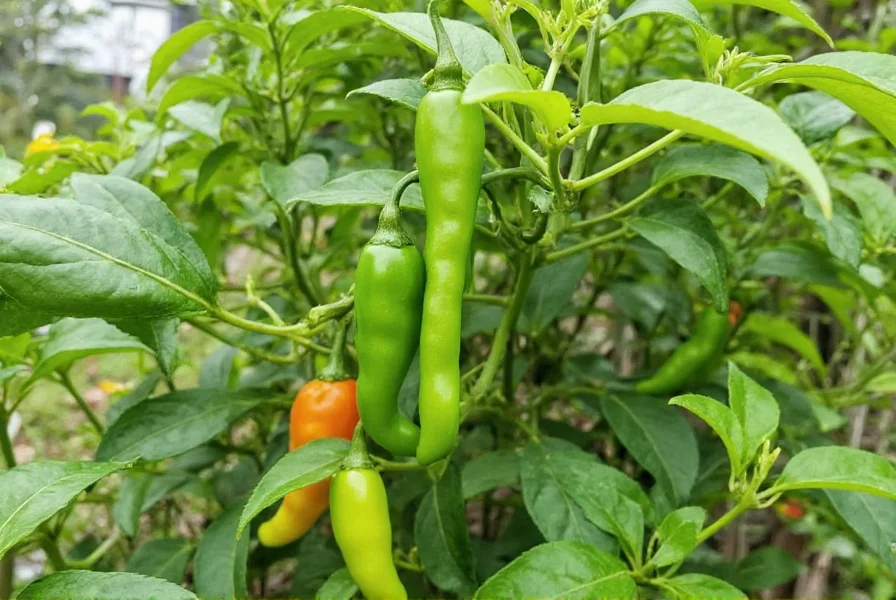Originating as a novelty pepper, the Peter Pepper has gained popularity among home gardeners seeking unique chili varieties. Despite its provocative appearance, this heirloom variety delivers a complex flavor profile with moderate heat that works well in salsas, pickling, and decorative arrangements. Understanding proper cultivation techniques ensures successful growth and abundant harvests.
Distinctive Characteristics of Peter Pepper Plants
Peter Pepper plants typically reach 24-36 inches in height with a bushy growth habit. The peppers themselves measure 3-4 inches long with a distinctive curved shape and prominent 'head' section. When immature, the fruits display a glossy green color that transitions through yellow and orange stages before reaching their final vibrant red hue at full maturity.
Heat-wise, Peter Peppers fall in the medium range of the Scoville scale (5,000-30,000 units), comparable to a serrano pepper but often milder in practice. The flavor profile features bright, slightly fruity notes with earthy undertones that intensify as the peppers mature. Each plant can produce 20-40 fruits under optimal growing conditions throughout the summer and early fall seasons.

Optimal Growing Conditions
For successful Peter Pepper cultivation, maintain these essential growing conditions:
| Growing Factor | Requirements | Notes |
|---|---|---|
| Temperature | 70-85°F (21-29°C) | Protect from temperatures below 50°F (10°C) |
| Sunlight | 6-8 hours daily | Full sun preferred for maximum fruit production |
| Soil Type | Well-draining, loamy | pH 6.0-7.0 with organic matter |
| Watering | 1-2 inches weekly | Maintain consistent moisture without waterlogging |
Planting and Care Instructions
Start Peter Pepper seeds indoors 8-10 weeks before your last expected frost date. Plant seeds ¼ inch deep in seed-starting mix, maintaining soil temperature around 80°F (27°C) for optimal germination, which typically occurs within 7-14 days.
When transplanting seedlings outdoors, space plants 18-24 inches apart in rows 30-36 inches apart. Incorporate compost or well-rotted manure into planting holes to provide essential nutrients. Apply 2-3 inches of organic mulch to conserve moisture and regulate soil temperature.
Regular care includes:
- Consistent watering to prevent blossom end rot
- Light fertilization every 3-4 weeks with balanced fertilizer
- Pruning lower leaves to improve air circulation
- Staking plants when fruiting begins to support weight
Common Growing Challenges and Solutions
Gardeners growing Peter Pepper chili plants may encounter several common issues:
Blossom drop: Caused by temperature extremes or inconsistent watering. Maintain stable temperatures and consistent soil moisture to prevent flower loss.
Leaf curling: Often indicates aphid infestation or insufficient water. Inspect undersides of leaves and treat with insecticidal soap if pests are present.
Slow growth: Typically results from cool temperatures or nutrient deficiency. Ensure plants receive adequate warmth and apply balanced fertilizer every 3-4 weeks during growing season.
Fruit discoloration: Uneven ripening may occur with inconsistent sunlight exposure. Rotate plants periodically if growing in containers to ensure even sun exposure.

Harvesting and Culinary Applications
Harvest Peter Peppers when they reach full color (typically vibrant red) and feel firm to the touch. Use sharp scissors or pruning shears to cut peppers from the plant, leaving a small stem attached. Wear gloves when handling hot varieties to prevent skin irritation.
Culinary uses for Peter Peppers include:
- Adding visual interest and moderate heat to salsas and relishes
- Pickling for decorative and flavorful condiments
- Roasting and incorporating into sauces and stews
- Drying for long-term storage and use in spice blends
- Using fresh as a conversation-starting garnish
When preserving your harvest, store fresh peppers in a paper bag in the refrigerator crisper drawer for up to two weeks. For longer storage, freeze whole peppers on a baking sheet before transferring to freezer bags, or dry them using a food dehydrator or oven on lowest setting.
Companion Planting Strategies
Implement these companion planting techniques to enhance your Peter Pepper chili plant growth:
Plant basil, oregano, or marigolds nearby to repel common pests like aphids and spider mites. Avoid planting near fennel or kohlrabi, which can inhibit pepper growth. Consider interplanting with矮生豆类 to fix nitrogen in the soil, benefiting your chili plants throughout the growing season.
Frequently Asked Questions
How long does it take for Peter Pepper plants to produce fruit?
Peter Pepper plants typically begin producing fruit 70-85 days after transplanting outdoors. The first flowers appear around 6-8 weeks after transplanting, with fruits reaching maturity approximately 4-6 weeks after pollination. In optimal conditions, you can expect your first harvest about 10-12 weeks after moving seedlings outdoors.
Are Peter Pepper plants perennial or annual?
Peter Pepper plants are technically perennials in their native tropical climate (USDA zones 10-11), but most gardeners grow them as annuals in temperate regions. In cooler climates, you can extend their life by bringing container-grown plants indoors before first frost, placing them in a sunny window with temperatures above 55°F (13°C).
Can you eat Peter Peppers when they're still green?
Yes, you can harvest and eat Peter Peppers when green, though they'll be milder and less sweet than fully ripened red peppers. Green Peter Peppers have a slightly grassy flavor with lower heat intensity. For maximum flavor complexity and nutritional value, allow peppers to fully ripen to red on the plant before harvesting.
What's the best way to store harvested Peter Peppers?
Store fresh Peter Peppers in a paper bag in your refrigerator's crisper drawer for up to two weeks. For longer storage, freeze whole peppers on a baking sheet before transferring to freezer bags (up to 6 months), or dry them using a food dehydrator. Pickling is another excellent preservation method that maintains both flavor and distinctive shape.
Do Peter Pepper plants require special pollination techniques?
No special pollination techniques are needed for Peter Pepper plants. These self-pollinating plants typically set fruit naturally with help from wind and visiting insects. In greenhouse or indoor settings with limited airflow, gently shaking the plants during flowering can improve pollination rates. Avoid using pesticides that might harm beneficial pollinators.











 浙公网安备
33010002000092号
浙公网安备
33010002000092号 浙B2-20120091-4
浙B2-20120091-4